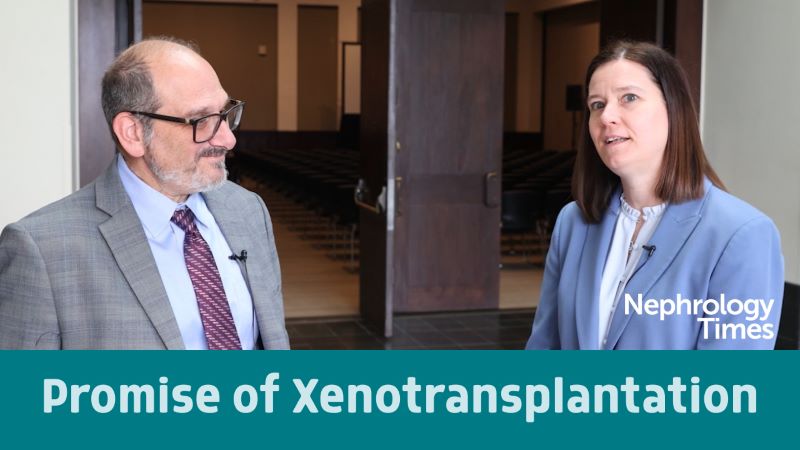
In recent years, long-term graft survival after kidney transplantation has improved, due, in part, to advances in immunosuppressive therapy and management of complications. Transplant recipients require lifelong immunosuppressive management to prevent allograft rejection as well as nonimmunologic complications, including chronic allograft dysfunction, cardiovascular diseases, infectious diseases, malignancy, hypertension, dyslipidemia, and diabetes mellitus. There are associations between those nonimmunologic complications and long-term use of immunosuppressive medications such as steroids and tacrolimus.
Currently, tacrolimus is the primary drug used as an immunosuppressant in kidney transplant recipients. Generally, lower tacrolimus concentration is associated with both patient nonadherence and inadequate immunosuppression, leading to acute rejection via the development of de novo donor-specific anti-human leukocyte antigen (HLA) antibodies (dnDSAs), particularly during the early phase following transplantation. High tacrolimus trough levels during the maintenance period may cause progressive arteriolar hyalinosis, arteriosclerosis, and interstitial fibrosis and tubular atrophy, also leading to deterioration in graft function.
There are few data available to help inform the optimal concentration of tacrolimus for long-term use in kidney transplant recipients. Kohei Unagami, MD, and colleagues at the Tokyo Women’s Medical University, Tokyo, Japan, conducted a retrospective study designed to examine the relationship between the maintenance of tacrolimus trough level and the appearance of dnDSAs during long-term follow-up after kidney transplantation.
The tacrolimus protocol at the Tokyo center has used a lower trough concentration since the 2000s. The review and statistical analysis evaluated the relationship between tacrolimus trough concentration and incidence of dnDSA over an average period of 7 years. Results were reported in Nephrology Dialysis Transplantation [2021;36(6):1120-1129].
Of the 994 patients who received a kidney transplant at the Department of Urology of Tokyo Women’s Medical University between 2000 and 2015, the study enrolled 584. Of the 584 study participants, 164 developed dnDSAs during the follow-up period and 420 did not. The enrolled patients were divided into Group 1 (no dnDSA, n=420) and Group 2 (dnDSAs, n=164). Average follow-up was 7.4 years, with no significant differences between the two groups.
In Group 2, dnDSAs appeared on average at 812 days following kidney transplantation. There were 140 cases of Class II dnDSAs (85.4%) and 50 cases of Class I dnDSAs (30.5%). There were no differences between the two study groups with regard to sex, duration of dialysis, or renal function prior to transplant. The incidence of IGA nephropathy was significantly higher in Group 1 than in Group 2. There were no significant differences between the groups in medical history of kidney transplantation, pregnancy, or blood transfusion.
The groups were similar in donor profiles (age, sex, and blood relationship with recipients). The number of mismatches in HLA-A/B/DR was more significant in Group 2 than in Group 1 (3.4 in Group 2 vs 2.8 in Group 1; P<.001). Patients with preformed DSA also showed a higher incidence of dnDSA production (48.2% in Group 2 vs 27.1% in Group 1; P<.001). The two groups were similar in the immunosuppressive regimen used.
During the follow-up period, the two groups were similar in mean tacrolimus concentration. There were no significant differences in the mean tacrolimus dosage per kilogram during the follow-up period, with the exceptions of at 6 months and 1 year following transplant. For each group as a whole, the mean trough concentration of tacrolimus was within set target ranges throughout the study period. Tacrolimus trough level was monitored at every follow-up appointment at the outpatient clinic and dosage was adjusted if needed. The researchers noted that intra-patient variability in tacrolimus exposure may have occurred due to patient nonadherence, abnormal absorption following gastrointestinal tract surgery, or pharmacologic interaction with other drugs; thus, some patients showed tacrolimus trough levels outside the target ranges.
The researchers conducted a logistic regression analysis to determine expected risk factors for the development of dnDSAs. The average tacrolimus trough concentration of each patient during the maintenance period was calculated based on 11 time points. Risk factors were preformed DSA (P=.001) and HLA-A/B/DR mismatches (P=.005). The average tacrolimus trough concentration was not a risk factor for the development of dnDSAs (P=.328).
Limitations to the study included tacrolimus levels in the participants being generally within a narrow range, lack of routine measurement of plasma concentration of mycophenolic acid, and the inclusion of ABO-incompatible kidney transplant cases in the study cohort.
In conclusion, the researchers said, “Our institution has used an immunosuppression protocol with lower target tacrolimus concentrations since the 2000s, with no significant differences in dnDSA incidence compared with other institutions. There were no clear relationships between dnDSA incidence and immunosuppressive regimen or tacrolimus trough level. Most notably, there were no significant differences in tacrolimus concentration during the observation period between patients who developed dnDSAs and those who did not. Therefore management of kidney transplant recipients at a lower tacrolimus concentration appears not to be a main risk factor for developing dnDSAs and its advantages should be taken into account with regard to long-term outcomes for patients and allografts. However, as development of dnDSAs is closely associated with allograft deterioration, immunosuppressive therapy that prevents dnDSA development is still required. Thus it is important to use appropriate immunosuppressive therapies that reduce the risk of complications, including those caused by the immunological sensitization of individual recipients.”
Takeaway Points
- Researchers at an institution in Japan with a tacrolimus protocol that uses a lower trough concentration as immunosuppressive management in kidney transplant recipients report results of a study examining the relationship between maintenance trough levels of tacrolimus and the rate of appearance of dnDSAs during long-term follow-up.
- The study cohort included 584 kidney transplant recipients; of those, 164 developed dnDSAs during the follow-up period.
- For kidney transplant recipients whose tacrolimus trough levels were kept within a narrow range, there was no clear relationship between tacrolimus trough level and incidence of dn






 © 2025 Mashup Media, LLC, a Formedics Property. All Rights Reserved.
© 2025 Mashup Media, LLC, a Formedics Property. All Rights Reserved.